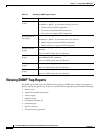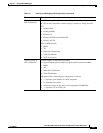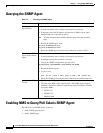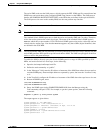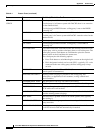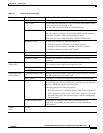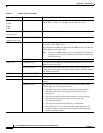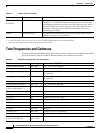
7-7
Cisco BTS 10200 Softswitch Operations and Maintenance Guide, Release 6.0.x
OL-16000-07
Chapter 7 Using the BTS SNMP Agent
Enabling NMS to Query/Poll Solaris SNMP Agent
The active EMS node runs the SAD process, which converts the BTS 10200 specific events/alarms into
SNMP traps and sends them to the configured SNMP Trap listeners or the NMSes. The SAD process
handles the SNMPWALK/GET/GETNEXT/SET on the OIDs that are defined in the opticall.mib file.
The SAD process also runs on the standby EMS, but does not perform any function.
Note The SAD process does not run on the CA nodes.
Note The CA runs only the standard Solaris SNMP agent.
The standard Solaris SNMP agent runs on both the active and standby EMS and CA nodes. Therefore,
all the four nodes generate the solaris-level traps. The name of the standard Solaris SNMP agent is
mibiisa, which runs on port number 13230. The Solaris SNMP agent can be used to collect the sun box
related statistics and/or traps. Note that the
mibiisa supports only those OIDs (object identifiers) that
are defined in the SUN MIB.
Note The active/standby EMS and active/standby CA nodes generate the solaris-level traps, whereas only the
active EMS generates BTS-specific traps and sends them to NMS. The NMS can query/poll all the four
nodes to receive the generated traps.
To enable the NMS to directly query the Solaris SNMP agent for a range of OIDs specified by SUN
MIBs, and receive Solaris box-level traps, do the following:
1. Open the /etc/snmp/conf/snmpd.conf file.
2. Define the read-community as “public”.
3. In the “Managers” field, enter the IP address or hostname of the NMS from where the user needs to
send the SNMP query. Enter multiple addresses separated by spaces, but leave the “localhost” entry
as is.
4. In the Trap field, configure the IP address or hostname of the NMS where the traps have to be sent.
5. Restart the SNMP agent, enter:
/etc/init.d/S98mibiisa stop
/etc/init.d/S98mibiisa start
6. Query the SNMP agent (using SNMPGET/SNMPWALK) from the Manager using the
read-community and port 13230. For example, to get the system up time, enter the following
command:
snmpwalk -c public -p 13230 prica07 system
The output appears as given below:
system.sysDescr.0 = Sun SNMP Agent
system.sysObjectID.0 = OID: enterprises.42.2.1.1
system.sysUpTime.0 = Timeticks: (279199168) 32 days, 7:33:11.68
system.sysContact.0 = System administrator
system.sysName.0 = prica07
system.sysLocation.0 = System administrators office
system.sysServices.0 = 72






